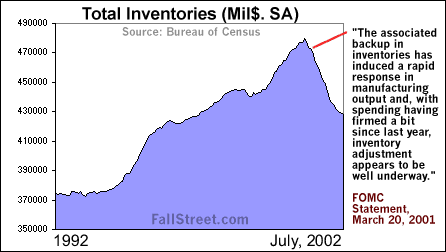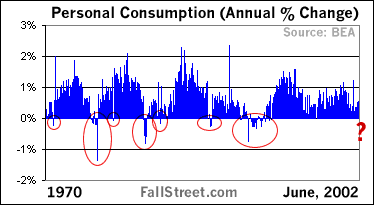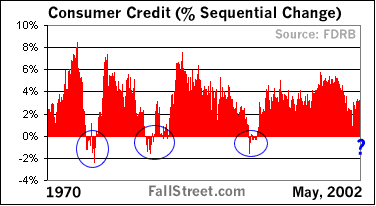|
Insofar as can be ascertained, there is no optimal growth level for the U.S. economy. In fact, growth is most often measured by comparing current growth to historical expansion and contraction extremes (cycles), not by any underlying static growth target. As such, and using the notion that porridge can either be ‘too hot’, ‘too cold’, or ‘just right’, achieving a consensus on what qualifies economic growth as being ‘just right’ is impossible. Rather, discussion of economic growth is quarantined to observing transitions between expansion and contraction – the economy is either heating up or cooling off.
With this in mind, the term ‘economic recovery’ is regularly used to describe the period from 4Q01-2Q02. The logic being that during these 3 quarters the economy expanded whereas during the previous 3 quarters the economy contracted (as BEA revisions have shown).
However, while steep declines in business investment due to the ‘unsustainable’ credit expansion is commonly labeled as one of the primary causes for the 2001 recession, evidence that this area of the economy has ‘recovered’ is not overwhelming (some might even say such evidence is non-existent). Instead, the period of negative growth in 2001 was altered by sharp increases in government and consumer spending. For certain, these two areas can in no way be said to have ‘recovered’ either. Rather, consumer and government spending have simply increased since 4Q01.
In sum, when looking at the recession/recovery objectively it can be concluded that while basic GDP growth is in ‘recovery’ mode the areas blamed for the previous contraction have, at best, merely stabilized.
Inventories Signal A False Recovery
Insofar as there can be no optimal level for economic growth, there can likewise be no optimal level for business inventories. Month-to-month declines in inventories do not, contrary the opinion of many fine economists, suggest that an economy is recovering. Rather, taken independently declines in inventories simply suggest declines in inventories.
That said, the argument could be made that if inventories fall ‘enough’ this presages an uptick in production (to replenish dwindling inventories). However, and as Greenspan and countless others have found out since early 2001, this premise is based upon inevitability – not predictability.
 |
Falling inventory levels, which supposedly forecasted an imminent pickup in capital spending in early 2002, were a false signal of a recovery. For that matter, ‘stabilizing inventory levels’, particularly in autos, have been an unreliable indicator for more than a year. In sum, at what level, if any, are inventory levels predictive of a widening economic turnaround?
“In the motor vehicle industry, inventory liquidation had been especially pronounced and the process now seemed largely completed.”
Minutes of the Federal Open Market Committee. March 20, 2001
The Most Dangerous ‘Inevitability’
Despite last years negative GDP readings the U.S. consumer has not ratcheted down their spending habits. In fact, personal consumption continues to increase month after month as it has for almost a decade.
 |
However, with the Fed being unable to marketably reduce interest rates, and with consumer confidence falling along with stocks, the danger is that what helped make last years recession short-lived will help ensure the current expansion is extra brief: the danger is that consumers will opt to increase savings rather than maintain or increase spending. Just as it is inevitable that dropping inventories at some point presage a production pickup it is also inevitable that rising consumer debt and spending predicts falling consumer debt and spending. That said, at what level, if any, are increases in consumer debt predictive of looming decreases in consumer debt?
 |
Conclusion
Although there is no optimal level of economic growth there is, however, ample evidence to suggest that consumer spending is ‘too hot’, corporate profits (pricing power) are ‘too cold’, and company balance sheets are not even close to being ‘just right’. In other words, strong consumer spending trends are unsustainable, corporate pricing power is not strong enough to warrant increases in capital spending, and balance sheets have not yet purged the excesses created during the 1990s. When combined these occurrences explain current economic and stock market weakness. Moreover, and despite the brief stock market/economic boom earlier this year, this triad of negatives has firmly been in place since late 2001.
Most people would concur that the economic ‘recovery’ has been manufactured by taxing an already heavily burdened consumer. As such, there has not really been a ‘recovery’ at all, but merely the continuance of strong consumer spending. With this in mind, the threat is that Goldilocks will be mauled when (not if!) the consumer takes a needed break to recover from a decade of rising debt loads.
In sum, the process of economic growth and contraction is understood by looking at vague and interconnected ‘inevitabilities’. Furthermore, that no economy can ever be said to be growing ‘just right’ can be ascertained by observing that while some areas are ‘too hot’ others are ‘too cold’. Those that choose to ignore consumer spending inevitabilities do so at their own peril: business investment, and pricing power (corporate profits) will be unable to sustain a prolonged heating up period so long as consumer spending is edging closer to a cooling off period.
|
|
All data and information within these pages is thought to be taken from reliable sources but there is no guarantee as such. All opinions expressed on this site are opinions and should not be regarded as investment advice.
Copyright © 2000, 2001, 2002
FallStreet.com
|
|
|
|